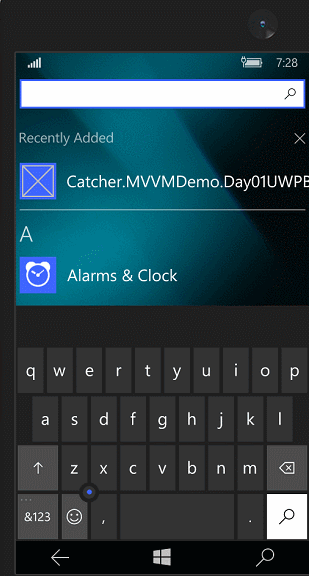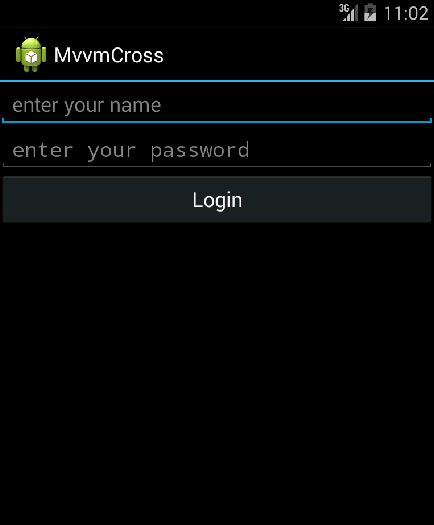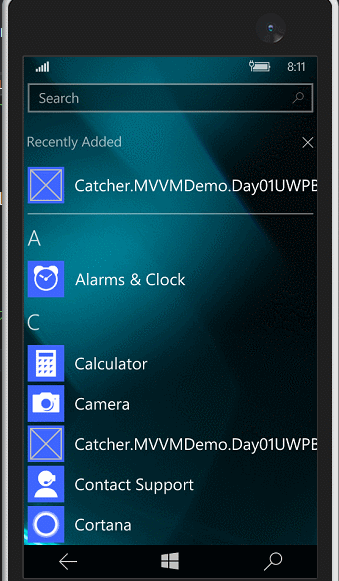Xamarin.Android和UWP之MVVM的简单使用(二)
2016-05-25 14:51
435 查看
0x01 前言
前面一篇,Xamarin.Android和UWP之MVVM的简单使用(一),主要讲了MvvmLight的简单使用这篇主要讲讲MvvmCross的简单使用,例子的话,还是和上篇的一样。直接进正题吧,不废话了。
0x02 简单的MVVM(mvvmcross) Demo
新建一个类库项目:Catcher.MVVMDemo.Day01CrossCore添加一个ViewModels文件夹,同时添加一个MainViewModel
using MvvmCross.Core.ViewModels;
namespace Catcher.MVVMDemo.Day01CrossCore.ViewModels
{
public class MainViewModel : MvxViewModel
{
public MainViewModel() { }
private string _input;
public string Input
{
get
{
return _input;
}
set
{
_input = value;
RaisePropertyChanged(() => Input);
}
}
}
}这里的ViewModel继承的是MvxViewModel。
在项目根路径添加一个App.cs
using Catcher.MVVMDemo.Day01CrossCore.ViewModels;
using MvvmCross.Core.ViewModels;
namespace Catcher.MVVMDemo.Day01CrossCore
{
public class App : MvxApplication
{
public override void Initialize()
{
RegisterAppStart<MainViewModel>();
}
}
}注册MainViewModel为启动的第一个视图模型
到这里,Xamarin.Android和UWP的公共部分已经完成了。
第一个例子(Xamarin.Android):
新建一个Android项目:Catcher.MVVMDemo.Day01DroidByMvvmCross
在根目录添加一个Setup.cs
using Android.Content;
using MvvmCross.Core.ViewModels;
using MvvmCross.Droid.Platform;
using Catcher.MVVMDemo.Day01CrossCore;
namespace Catcher.MVVMDemo.Day01DroidByMvvmCross
{
public class Setup : MvxAndroidSetup
{
public Setup(Context applicationContext)
: base(applicationContext)
{
}
protected override IMvxApplication CreateApp()
{
return new App();
}
}
}在Setup中,主要是返回了我们在Core里面编写的App.cs
然后修改我们的Main.axml
<?xml version="1.0" encoding="utf-8"?> <LinearLayout xmlns:android="http://schemas.android.com/apk/res/android" xmlns:local="http://schemas.android.com/apk/res-auto" android:orientation="vertical" android:layout_width="match_parent" android:layout_height="match_parent"> <EditText android:layout_width="match_parent" android:layout_height="wrap_content" local:MvxBind="Text Input" /> <TextView android:layout_width="match_parent" android:layout_height="wrap_content" local:MvxBind="Text Input" /> </LinearLayout>
通过local:MvxBind来实现绑定。
新建一个文件夹Activities,同时添加一个MainActivity
using Android.App;
using MvvmCross.Droid.Views;
namespace Catcher.MVVMDemo.Day01DroidByMvvmCross.Activities
{
[Activity(Label = "MvvmCross", MainLauncher = true)]
public class MainActivity : MvxActivity
{
protected override void OnViewModelSet()
{
SetContentView(Resource.Layout.Main);
}
}
}Activity的代码很简单,就是指定视图。
到这里已经可以成功运行了,效果如下:

第二个例子(UWP):
步骤基本与Xamarin.Android一致!
新建一个UWP项目:Catcher.MVVMDemo.Day01UWPByMvvmCross
添加一个Setup.cs
using MvvmCross.Core.ViewModels;
using MvvmCross.WindowsUWP.Platform;
using Windows.UI.Xaml.Controls;
namespace Catcher.MVVMDemo.Day01UWPByMvvmCross
{
public class Setup : MvxWindowsSetup
{
public Setup(Frame rootFrame) : base(rootFrame)
{
}
protected override IMvxApplication CreateApp()
{
return new Day01CrossCore.App();
}
}
}注意与Android的区别!!
修改App.xaml.cs,将设置启动页注释掉,换成我们刚才的Setup.cs,具体如下:
if (e.PrelaunchActivated == false)
{
if (rootFrame.Content == null)
{
//rootFrame.Navigate(typeof(MainPage), e.Arguments);
var setup = new Setup(rootFrame);
setup.Initialize();
var start = Mvx.Resolve<IMvxAppStart>();
start.Start();
}
Window.Current.Activate();
}把新建项目生成的MainPage干掉,同时在根目录添加一个Views文件夹,用来存放我们的Page
新建一个MainPage.xaml,修改布局如下:
<views:MvxWindowsPage
x:Class="Catcher.MVVMDemo.Day01UWPByMvvmCross.Views.MainPage"
xmlns="http://schemas.microsoft.com/winfx/2006/xaml/presentation"
xmlns:x="http://schemas.microsoft.com/winfx/2006/xaml"
xmlns:local="using:Catcher.MVVMDemo.Day01UWPByMvvmCross.Views"
xmlns:d="http://schemas.microsoft.com/expression/blend/2008"
xmlns:mc="http://schemas.openxmlformats.org/markup-compatibility/2006"
xmlns:views="using:MvvmCross.WindowsUWP.Views"
mc:Ignorable="d">
<Grid Background="{ThemeResource ApplicationPageBackgroundThemeBrush}">
<StackPanel Margin="20">
<TextBlock FontSize="14" HorizontalAlignment="Center" Text="MvvmCross UWP Demo" />
<TextBox
x:Name="txtInput"
/>
<TextBlock Text="{Binding ElementName=txtInput,Path=Text}" />
</StackPanel>
</Grid>
</views:MvxWindowsPage>要注意的是,用的是MvvmCross的布局MvxWindosPage
并且,MainPage.xaml.cs也要修改!!
using MvvmCross.WindowsUWP.Views;
namespace Catcher.MVVMDemo.Day01UWPByMvvmCross.Views
{
public sealed partial class MainPage : MvxWindowsPage
{
public MainPage()
{
this.InitializeComponent();
}
}
}都是用MvvmCross自己的东西!如果忘记修改,运行效果是一片黑。
到这里已经OK了,效果如下

0x03 MVVM(mvvmcross) 登陆Demo
登陆失败时要有个对话框提示,我们要先新建一个IDialogServicenamespace Catcher.MVVMDemo.Day01CrossCore
{
public interface IDialogService
{
void Alert(string message, string title, string okbtnText);
}
}在刚才的类库项目中添加一个LoginViewModel
using MvvmCross.Core.ViewModels;
namespace Catcher.MVVMDemo.Day01CrossCore.ViewModels
{
public class LoginViewModel : MvxViewModel
{
private readonly IDialogService _dialogService;
public LoginViewModel(IDialogService dialogService)
{
_dialogService = dialogService;
}
private string _Name;
public string Name
{
get
{
return _Name;
}
set
{
_Name = value;
RaisePropertyChanged(()=>Name);
}
}
private string _password;
public string Password
{
get
{
return _password;
}
set
{
_password = value;
RaisePropertyChanged(()=>Password);
}
}
private IMvxCommand _loginCommand;
public virtual IMvxCommand LoginCommand
{
get
{
_loginCommand = _loginCommand ?? new MvxCommand(Login);
return _loginCommand;
}
}
private void Login()
{
if (Name=="catcher"&&Password=="123")
{
ShowViewModel<MainViewModel>();
}
else
{
_dialogService.Alert("check your name and password", "Infomation", "OK");
}
}
}
}登陆的逻辑处理还是和上一篇一样。
修改我们的App.cs
using Catcher.MVVMDemo.Day01CrossCore.ViewModels;
using MvvmCross.Core.ViewModels;
using MvvmCross.Platform;
using MvvmCross.Platform.IoC;
namespace Catcher.MVVMDemo.Day01CrossCore
{
public class App : MvxApplication
{
public override void Initialize()
{
CreatableTypes()
.EndingWith("Service")
.AsInterfaces()
.RegisterAsLazySingleton();
RegisterAppStart<LoginViewModel>();
//demo 1
//RegisterAppStart<MainViewModel>();
}
}
}第三个例子(Xamarin.Android):
在Catcher.MVVMDemo.Day01DroidByMvvmCross中添加一个Services文件夹
同时添加一个DialogService去实现我们刚才定义的IDialogService接口。
using Android.App;
using MvvmCross.Platform;
using Catcher.MVVMDemo.Day01CrossCore;
using MvvmCross.Platform.Droid.Platform;
namespace Catcher.MVVMDemo.Day01DroidByMvvmCross.Services
{
public class DialogService : IDialogService
{
/// <summary>
/// show the alert dialog
/// </summary>
/// <param name="message">the message of the dialog</param>
/// <param name="title">the title of the dialog</param>
/// <param name="okbtnText">the text of the button</param>
public void Alert(string message, string title, string okbtnText)
{
//activity
var topActivity = Mvx.Resolve<IMvxAndroidCurrentTopActivity>();
var context = topActivity.Activity;
//alert dialog
var adb = new AlertDialog.Builder(context);
adb.SetTitle(title);
adb.SetMessage(message);
adb.SetPositiveButton(okbtnText, (sender, args) => { });
adb.Create().Show();
}
}
}这里用到了AlertDialog。
在Setup.cs中注册一下这个Service,重写InitializeFirstChance 方法
protected override void InitializeFirstChance()
{
base.InitializeFirstChance();
Mvx.RegisterSingleton<IDialogService>(() => new DialogService());
}添加一个login.axml
<?xml version="1.0" encoding="utf-8"?> <LinearLayout xmlns:android="http://schemas.android.com/apk/res/android" xmlns:local="http://schemas.android.com/apk/res-auto" android:orientation="vertical" android:layout_width="match_parent" android:layout_height="match_parent"> <EditText android:layout_width="match_parent" android:layout_height="wrap_content" android:hint="enter your name" local:MvxBind="Text Name" /> <EditText android:layout_width="match_parent" android:layout_height="wrap_content" android:inputType="textPassword" android:hint="enter your password" local:MvxBind="Text Password" /> <Button android:layout_width="match_parent" android:layout_height="wrap_content" android:text="Login" local:MvxBind="Click LoginCommand" /> </LinearLayout>
在Activities文件夹添加一个LoginActivity
using Android.App;
using MvvmCross.Droid.Views;
namespace Catcher.MVVMDemo.Day01DroidByMvvmCross.Activities
{
[Activity(Label = "MvvmCross", MainLauncher = true)]
public class LoginActivity : MvxActivity
{
protected override void OnViewModelSet()
{
SetContentView(Resource.Layout.login);
}
}
}去掉,MainActivity中的Mainlauncher=true
OK,效果如下:

第四个例子(UWP):
在Catcher.MVVMDemo.Day01UWPByMvvmCross中添加一个Services文件夹
同时添加一个DialogService去实现我们刚才定义的IDialogService接口。
using Catcher.MVVMDemo.Day01CrossCore;
using System;
using Windows.UI.Xaml.Controls;
namespace Catcher.MVVMDemo.Day01UWPByMvvmCross.Services
{
public class DialogService : IDialogService
{
public async void Alert(string message, string title, string okbtnText)
{
var dialog = new ContentDialog()
{
Content = message,
Title= title,
PrimaryButtonText = okbtnText
};
dialog.PrimaryButtonClick += (s, e) => { };
await dialog.ShowAsync();
}
}
}这里用ContentDialog去实现这个提示。
在Setup.cs中注册一下这个Service,重写InitializeFirstChance 方法
protected override void InitializeFirstChance()
{
base.InitializeFirstChance();
Mvx.RegisterSingleton<IDialogService>(() => new DialogService());
}在Views文件夹添加一个LoginPage.xaml
<views:MvxWindowsPage
x:Class="Catcher.MVVMDemo.Day01UWPByMvvmCross.Views.LoginPage"
xmlns="http://schemas.microsoft.com/winfx/2006/xaml/presentation"
xmlns:x="http://schemas.microsoft.com/winfx/2006/xaml"
xmlns:local="using:Catcher.MVVMDemo.Day01UWPByMvvmCross.Views"
xmlns:d="http://schemas.microsoft.com/expression/blend/2008"
xmlns:mc="http://schemas.openxmlformats.org/markup-compatibility/2006"
xmlns:views="using:MvvmCross.WindowsUWP.Views"
mc:Ignorable="d">
<Grid Background="{ThemeResource ApplicationPageBackgroundThemeBrush}">
<Grid.RowDefinitions>
<RowDefinition Height="*"></RowDefinition>
<RowDefinition Height="*"></RowDefinition>
<RowDefinition Height="*"></RowDefinition>
<RowDefinition Height="*"></RowDefinition>
<RowDefinition Height="5*"></RowDefinition>
</Grid.RowDefinitions>
<TextBox Grid.Row="1" Margin="15" Height="20" Text="{Binding Name,Mode=TwoWay}" PlaceholderText="enter you name" />
<PasswordBox Grid.Row="2" Margin="15" Height="20" Password="{Binding Password,Mode=TwoWay}" PasswordChar="*" PlaceholderText="enter your password" />
<Button Grid.Row="3" Margin="15,10" Content="Login" Command="{Binding LoginCommand}" HorizontalAlignment="Stretch" VerticalAlignment="Stretch" />
</Grid>
</views:MvxWindowsPage>LoginPage.xaml.cs
using Catcher.MVVMDemo.Day01CrossCore.ViewModels;
using MvvmCross.WindowsUWP.Views;
namespace Catcher.MVVMDemo.Day01UWPByMvvmCross.Views
{
public sealed partial class LoginPage :MvxWindowsPage
{
public new LoginViewModel ViewModel
{
get { return (LoginViewModel)base.ViewModel; }
set { base.ViewModel = value; }
}
public LoginPage()
{
this.InitializeComponent();
}
}
}OK,效果如下 :

0x04 简单总结
MvvmCross用起来跟MvvmLight基本是一样ViewModel这一块与MvvmLight的ViewModel基本没有太大的差别
其他方面,复杂一点的时候,工作量基本差不多,各有各的好,使用的话,都是看个人的兴趣爱好。
MvvmCross也在不断更新,昨天是4.1.5版本,今天就4.1.6了。
官网:https://mvvmcross.com/
Github:https://github.com/MvvmCross
相关文章推荐
- MVP模式在Android项目中的使用
- 实例讲解Android中SQLiteDatabase使用方法
- android ndk 创建过程
- Android SO文件保护加固(一)
- Android AlertDialog实现半透明的弹窗
- 侧滑可以删除的ListView
- Android巧用ActionBar实现下拉式导航
- android自定义View时报 error: No resource identifier found for attribute ‘XXX’ in package 'XXX'
- Android Studio快捷键整理
- Android Studio2.1版本后使用虚拟机碰见的问题总结
- Android studio 导入第三方类库工程 转
- Android 简述touch事件中的MotionEvent
- android shape的使用
- Android自定义ViewGroup的实现方法
- android 中 EditText加入图标 更改边框颜色 设置透明 代码
- Android事件总线 ( AndroidEventBus ) 开源库发布
- Android Studio导入并运行github下载的开源项目【转自 “阿敏其人” 简书博客】
- Android中的windowSoftInputMode属性详解
- Android性能优化
- Android开发之多线程编程Thread和Runnable使用
